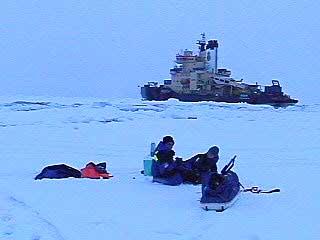
|
|
4 August, 2001
Blowin' in the Wind
Saturday, 4 August 2001
God afton!
Life on Board
You must be adaptable, resilient, and ready to move at all times on this
expedition. Early this morning, I heard the ship engines turn on. I raced
downstairs to see what was going on and found that they were going to turn
the ship around because the wind had changed direction. My scientific brain
said, wait a minute.this is supposed to be a drift station with no
disturbance of the natural surroundings. The reason was that they need to
have the wind blowing from the front of the ship towards the back because
all the instruments that measure gases and parcticles are at the front of the
ship. If the wind is blowing from the back, it picks up stuff from the ship
before it gets to the front deck and registers on the instruments. It took
about an hour to un-anchor and disconnect all of the power running out to
the ice camps. Then it took another hour to turn the ship, then another to
reconnect. Scientists on the ice said it felt really strange to see the
ship leaving them as it went to turn around.
About an hour after we got resettled, the announcement came that they needed
to turn the ship again so if anyone wanted to go onto the ice, it had to be
now. People jumped up from lunch and started running to get gear and
equipment. Otherwise, it would be a few hours again until there would be
ice access. I hope this doesn't happen too often or we will have many
disgruntled scientists.
Where Are We Now?
It wasn't snowing today but it looked threatening for most of the day.
Expedition leaders are holding their breath because we are starting to drift
a little more towards the east. Our coordinates at lunchtime were 88o46' N
by 4o12' W. This puts us in the Amundsen Basin between the Lomonosov Ridge
and the Gakkel Ridge.
Scientists at Work
This afternoon I went out with the ice coring team, Tuomo Roine from
Helsinki, and Zoe Fleming from England. While we were waiting for the
snowmobile to arrive with our equipment, we sat in the snow and had some
coffee to warm up. After our equipment arrived, we drilled three cores,
each about 130 centimeters in length. Ice expert Tuomo said that the really
thick ice they had drilled the other day (4 meters) was actually at least
two ice floes "rafted" on top of each other. What we drilled today was new
ice from this year. The first core was cut into 20 cm pieces and put in
buckets to be taken back to the lab and melted slowly to look for organisms,
keeping the bottom 5 cm for especially close observation of ice algae
growing under the ice. The second core was also cut into 20 cm pieces and
put into bags for nutrient analysis after melting. Then we took another
core and stuck a thermometer into the center every 10 centimeters and
recorded the data. When we were done, we decided to have a little fun by
burying Tuomo in the snow as if we were at the beach in the sand, with just
his head sticking out. As far as I can tell, the Finns actually enjoy being
cold and he said that he was quite comfortable. Who says science in the
snow isn't fun?
Vi ses! (See you later!)
From Deck 4 on the Icebreaker Oden, drifting through the ice, a little east,
88 North,
Dena Rosenberger

Coffee break on the ice
Contact the TEA in the field at
.
If you cannot connect through your browser, copy the
TEA's e-mail address in the "To:" line of
your favorite e-mail package.
|
